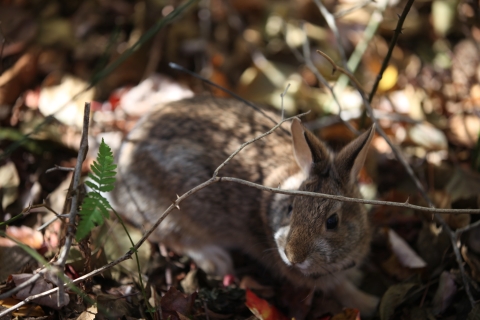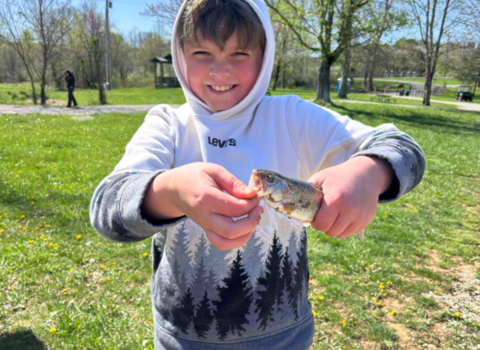On warm, windless days in late spring, small brown butterflies flit among yellow wildflowers blooming around earthen mounds within a secured perimeter on Cape Cod. Until 1999, those mounds held shooting targets for soldiers in training.
“In just 20 years, we’ve transformed an old rifle range into a flagship conservation area conservation area
A conservation area or wildlife management area is a type of national wildlife refuge that consists primarily or entirely of conservation easements on private lands. These conservation easements support private landowner efforts to protect important habitat for fish and wildlife. There are 15 conservation areas and nine wildlife management areas in the National Wildlife Refuge System.
Learn more about conservation area for a whole suite of species, including the frosted elfin butterfly,” said Jake McCumber, Natural Resources and Training Lands Manager for the Massachusetts Army National Guard.
Today, the retired portion of the range at the National Guard’s Camp Edwards is a prime example of pine barrens, a rare habitat type characterized by sandy soil, fire-dependent conifers, dense thickets of scrub oak, and grassy openings that support specialized plants like wild indigo — one of two host plants the frosted elfin needs to survive.
The site is also a prime example of the Army’s dual mandate to protect both wildlife and national security.
Recognizing that military lands contain some of the nation’s most valuable natural assets, Congress passed the Sikes Act in 1960. It requires Department of Defense installations to develop natural resource management plans in coordination with conservation experts: state wildlife agencies and the U.S. Fish and Wildlife Service, which must approve the plan for activities that affect natural resources to continue.
Natural resource staff make sure activities coexist peacefully. The retired range at Camp Edwards populated with rare butterflies is adjacent to an active one.
“The purpose of our site is training, but we have to meet conservation goals in order for training to continue,” McCumber explained. “We have hundreds, if not thousands, of soldiers on site training on any given week, particularly in the summer, and we do it in concert with conservation success.”
While the camouflaged frosted elfin is the poster child for that success, numerous other species are thriving in the secure habitat afforded by the largest National Guard training area in the Northeastern U.S.
Slender clearwing moths, American woodcocks, Walsh’s digger bees, and the largest population of eastern whip-poor-will in the Commonwealth of Massachusetts all indicate that the natural resource program is meeting the mark.
An offshoot
Most Department of Defense installations have an Integrated Natural Resources Management Plan (INRMP) identifying key natural resources and the actions needed to manage them — and the frosted elfin is often an easy target. The butterfly has been recorded in the grassy savannas of at least five Department of Defense installations within its eastern U.S. range.
The common denominator among these installations is prescribed fire, an essential tool for sustaining plant species that depend on periodic burning to complete their life cycles, and the wildlife that depend on those plants. For thousands of years, open habitats like pine barrens were maintained naturally through wildfires, and intentionally through burns set by Native Americans to manage the landscape for hunting and other activities.
Now in a landscape dominated by mature forests and developed lands, Camp Edwards has become an oasis for these plant species, largely because fire is also an important tool for the safe operation of training installations: ammunition and woody debris can be a dangerous combination.
When soldiers began to train at the camp in the 1940s, accidental fires took place as an offshoot of artillery training, helping keep habitats open.
In the 1980s, the Army first attempted to use prescribed fire as a tool for hazard reduction at Camp Edwards. But it wasn’t until the 1990s that managers developed a methodology for using fire for conservation in Massachusetts and began documenting the benefits at Camp Edwards and elsewhere.
“We have been conducting annual bird surveys since 1994, along with a wide variety of other research and monitoring efforts for natural resources,” McCumber said.
Those data both inform and affirm management. McCumber explained they have been monitoring two bird species that use different habitat types — scarlet tanager and brown thrasher — for 25 years. Both are thriving.
“The bird populations show our efforts are working across the training site, and we’ve seen a particularly remarkable response in terms of restoring pine barrens habitat,” he said.
Reignited
While numerous winged wildlife are thriving on Camp Edwards today, an elusive, furry mammal helped reignite the proactive management approach that sustains them.
In 2006, natural resource staff at the base found New England cottontail, a species that had been declining across its native range due to habitat loss and competition from eastern cottontail, an introduced game species.
Working with the Service, the staff assessed the New England cottontail’s status on the installation, and developed a set of management actions — including prescribed fire — that would maintain the rare habitat it needs. As part of the plan, Camp Edwards Conservation Biologist Annie Curtis co-led a study on New England cottontail that validated the approach.
Using radio telemetry and pellet surveys, Curtis and a colleague found that rabbits mainly used areas that had burned in the past. It appeared that a 2,200-acre artillery practice zone known as the “Impact Area” — deactivated in 1997 — was a hotspot for the species.
Like frosted elfin and whip-poor-will, New England cottontail depend upon young habitat. In the rabbit’s case, dense, protective thicket, rather than open, sunny grasslands. But just as encroaching hardwoods will eventually shade out a sunny area, thicket will thin as vegetation matures. It takes intervention to keep these habitats forever young.
With funding support from the Service, and a Competitive State Wildlife Grant, Camp Edwards developed New England cottontail-focused restoration plans involving prescribed fire and forestry, and began implementing them in 2013.
“We have burned more than 2,300 acres since then,” McCumber said. “So far, it seems to be working, and we’re putting checks in place to make sure it continues to work.” For New England cottontail, and for other species like frosted elfin and eastern whip-poor-will.
The natural resources staff have expanded surveys in step with the expansion of the fire program. They’re building a statistically rigorous monitoring program that will help them tweak variables and measure ecological responses.
While the conservation initiatives at Camp Edwards may not be directly transferable to other sites in the Northeast — the installation has more leeway to use fire because of its size, security, and training needs — the base serves as a sort of proving ground for managing early successional habitat.
“That’s the beauty of all the interconnecting partnerships in the region, like the New England Cottontail Initiative and the North Atlantic Fire Science Exchange,” McCumber said. “We are working together to learn how to be more efficient, and more effective.”
It’s a shared mission.
The effort to conserve at-risk wildlife and recover listed species is led by the Service and state wildlife agencies in partnership with other government agencies, private landowners, conservation groups, tribes, businesses, utilities, and others. It has drawn support for its use of incentives and flexibilities within the Endangered Species Act to protect rare wildlife, reduce regulations, and keep working lands working.




